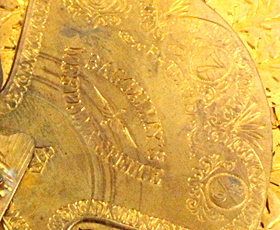Scallop Shell

Needle Case

Design Representation
Design Details
Needle Case Type: |
Figural |
Patent/Registered to: |
William Avery & Son - Redditch |
Patent/Design Representation #: |
Ornamental Class1: Metal: #257721 |
Patent/Design Registration Date: |
November 14, 1871 |
Location of Patent/Design Registration: |
The National Archives (TNA) - Kew, UK |
Reference #: |
TNA Representation - BT 43/31/257721
TNA Register - BT 44/2/257721 |
Dimensions: |
7 x 1.3 x 6.9
|
Material: |
Brass |
Name Variations: |
a) W. Avery & Son - Redditch
b) Baggallays, Westall & Spence - London
c) Copestake, Moore, Crampton & Co. – London
d) John English & Co. – Feckingham
e) Hayes, Crossley & Co. – London and Alcester
f) Hutton & Co - London
g) H. Milward & Sons - Redditch
h) W. Whiteley – Westbourne Grove (the sole source of this information is Horowitz and Mann as no example of this needle case
with this company name has been seen by the authors of this website) |
Other Variations: |
a) Nickel-silver version
b) Interior part cut-out
c) Interior part not cut-out
d) Interior engraving version 1
e) Interior engraving version 2 |
Additional Photographs


Front and back open views


Interior details


Interior Milward signature detail and Hayes signature detail (photo courtesy of Bunny's Place)


Interior Copestake signature detail and interior Avery signature detail with cut-out (photos from eBay)


Nickel-silver with interior engraving version 1 and English signature and brass version with interior engraving
version 2 and Avery signature without cut-out (photo courtesty of Sandi Falconer)


Nickel-silver exterior and Hutton interior signature detail (photo courtesy of the Winterthur Museum Collection)

With Baggallays, Westall & Spence signature detail (photo from Bleasdales Ltd. auction in November 2024)
Facts
The scallop is a species of marine shellfish which are located in all of the world’s oceans. Their fan-shaped shells with ridges are
often collected and the pattern is frequently found in artistic motifs and works of art. Scallops have dozens of tiny blue eyes along
the edge of their shell that help them monitor their environment for dangerous predators. The most common edible part is the abductor
mussel which is found near the center and provides the species with its ability to swim. Scallops are able to swim by repeatedly opening
and closing their shell with a clapping motion.

History
The scallop shell has been a popular motif in art since ancient times and was often used to depict fertility. It is for this reason
that Venus, the Roman goddess of love and fertility, frequently is portrayed with a scallop shell. This was best captured in 1486 by the
Italian Renaissance painter Sandro Botticelli in his most famous painting entitled ‘The Birth of Venus’ which is partially pictured
below. Decorative scallop shell-shaped bowls, plates, serving dishes, molds and silverware were common in the 18th and 19th centuries.

Miscellaneous
Everyone has heard of the term 'scalloped' but few realize that it was originally used to describe a creamy seafood dish that was served
hot in the shell. Today, the term is used to refer to a creamy casserole dish such as scalloped potatoes. The white meaty part
of the scallop is cooked in many different ways, however some consider them best when lightly dusted with flour and pan seared in butter, then
served with sliced lemon like the ones shown here.























